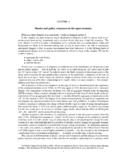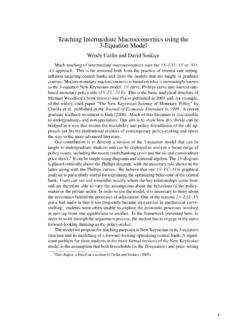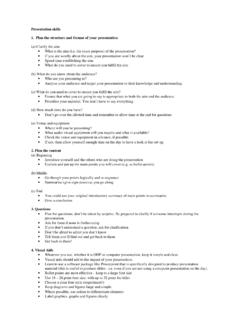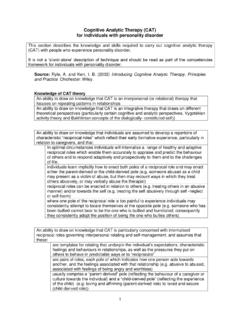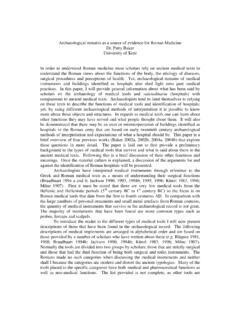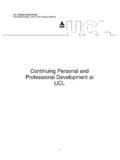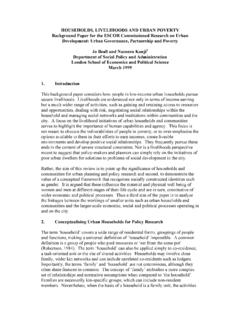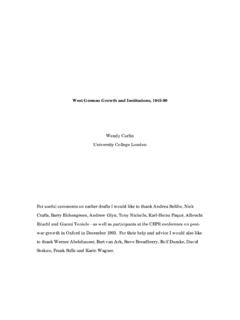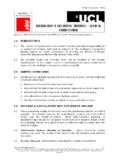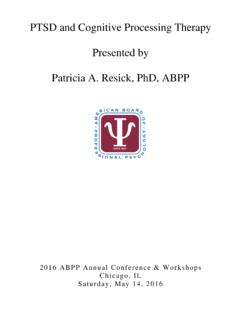Transcription of Post Traumatic Stress Disorder (PTSD)
1 Problem-specific competences describe the knowledge and skills needed when applying CBT principles to specific conditions. They are not a stand-alone description of competences, and should be read as part of the CBT competence framework. Effective delivery of problem-specific competences depends on their integration with the knowledge and skills set out in the other domains of the CBT competence framework. Post Traumatic Stress Disorder (PTSD) Cognitive Processing Therapy (CPT) Resick model Sources: Resick, & Schnicke, (1996) Cognitive processing therapy for rape victims.
2 London: Sage Publications Resick , Monson and Chard (2007) Cognitive processing therapy: Veteran/Military version Washington, DC: Department of Veterans Affairs Knowledge An ability to be aware of, and to draw on, knowledge of the psychological and social difficulties presented by clients with a diagnosis of PTSD An ability to draw on knowledge of the principles underlying Cognitive Processing Therapy (which combines cognitive restructuring and exposure, and whose goal is to help the client review and revise the schemas and beliefs about themselves which have developed as a consequence of trauma.)
3 And which contribute to the development and maintenance of symptoms of PTSD) Assessment An ability to use the assessment interview both to gather information, but also to normalise the client s reactions to the trauma ( to help alleviate the client s concerns that PTSD symptoms represent an unusual reaction) An ability to use a structured interview to gather information about the Traumatic incident itself and the client s reactions to it, social support and any history of other Traumatic events An ability to distinguish between PTSD and other disorders that may be triggered by a Traumatic event.
4 An ability to determine whether PTSD is the primary presenting problem, and to identify any other psychological, social and physical problems that may be present An ability to identify factors that have affected the severity of reactions, and which facilitated or hindered recovery ( negative reactions from others in response to the trauma) An ability to administer and interpret standardised measures of PTSD and depression ( the PTSD checklist (PCL), and the Beck Depression Inventory), and to monitor progress using these instruments An ability to work with clients who find it difficult to disclose the full extent of their experiences as a consequence of guilt and shame An ability to identify clients who may not be suited to CPT at this stage of their presentation.
5 Clients who respond to any discussion of the trauma with very severe panic (who may require initial intervention focused on management of panic) clients with very marked levels of dissociation clients who show high levels of avoidance combined with low levels of intrusions, (and who may require specific help to manage and reduce avoidance in order to respond to the therapy) Engagement An ability to help the client trust the therapist, by conveying an attitude that the therapist can listen to and contain the client s disclosures and reactions ( by not overreacting to disclosures with obvious shock, blame or fear) An ability to help the client feel safe and understood, and to use empathy to demonstrate (within and through the therapeutic relationship)
6 That the client s current beliefs and feelings, as well as their actions at the time of the Traumatic event, are comprehendible and acceptable An ability to recognise when secondary traumatisation reduces the therapist s capacity to respond to the client appropriately, and to seek support and supervision to manage this INTERVENTION An ability to introduce and implement the components of the programme in a manner which is flexible and which is responsive to the issues the client raises, but which also ensures that all relevant components are included An ability to ensure that the programme is implemented in a manner which is congruent with the principles of guided discovery Structuring sessions An ability to ensure that the intervention as a whole is structured so as to introduce each elements of the intervention programme in an organized and progressive manner.
7 Integrating new information with continuous review of prior learning An ability to convey to the client basic expectations of the programme (that sessions will be structured, and involve regular attendance and practice assignments) An ability to structure each session, by working with the client to construct an agenda An ability to ensure that each session includes review of practice assignments, and discussion of plans for future practice assignments Where clients have found it too difficult to carry out practice assignments as a consequence of avoidance, an ability to ensure that this is carried out in the session ( to help the client manage and challenge avoidance)
8 Education regarding PTSD and rationale for the intervention programme An ability to outline the main symptoms of PTSD (re-experiencing of the event, avoidance of reminders of the event, and high levels of arousal), and to help the client relate this outline to their own experience (with the aim of helping to normalise their symptoms) An ability to outline pathways to recovery from trauma, and the ways in which these can be disrupted in people with PTSD (fight-fright and freezing reactions, and their pairing with cues at the time of trauma) An ability to offer a cognitive formulation in order help the client begin to understand the development and maintenance of their symptoms ( that the client s beliefs influence the way in which they have processed the trauma and its aftermath)
9 An ability to help the client distinguish between emotions engendered directly by the Traumatic event, and feelings which reflect the client s subsequent interpretations of the event An ability to help the client understand the intervention programme, in particular its emphasis on the client s thoughts and interpretations of the Traumatic event While acknowledging their fears, an ability to help the client understand the role of avoidance in maintaining their symptoms, to Stress the importance of confronting their fears, and to signal the ways in which avoidance could manifest itself during therapy ( in non-completion of practice assignments, or difficulty in coming to sessions)
10 An ability to help the client understand the rationale for self-monitoring, and to facilitate its use both as part of assessment and throughout the intervention by regular review of self-monitoring materials Identifying the meaning of the Traumatic event Impact statement An ability to help the client initiate review of the trauma by asking them to write an impact statement as a practice assignment (focusing not on the details of the event, but: on their thoughts about why the event occurred, its causes, and how it has impacted on themselves and on others on the ways the event has influenced their beliefs about themselves, others and the world) An ability to identify, and help overcome, any difficulties or worries the client has about writing the statement (and other writing tasks involved in the exposure element of the programme)
